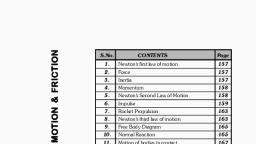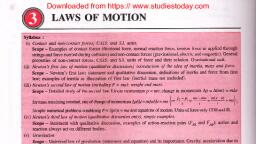Page 1 :
Chapter 5, , Laws of Motion, , e Introduction Introduction, , e Aristotle's Fallacy When we look around us, we find the planets moving around the sun, in orderly manner, movement of machinery parts in a factory, phases, , 2 ft of the moon - all of them are following certain laws. They all are acted, , e Newton's First Law of upon by certain forces. In the preceding two chapters, we described, Motion motion in terms of displacement, velocity and acceleration, ie., we, * Newton's Second Law of used kinematic quantities for describing motion without considering, Motion what might cause that motion. In order to understand this beauty, let, , us take a step forward by understanding "Force and laws of motion"., In this chapter, we shall study about force and its effects on the objects, and various laws related to motion of the objects., , © Newton's Third Law of, Motion, , e Conservation of Momentum, , , , @ Common Forces in ARISTOTLE’S FALLACY, Mechanics Aristotle, a Greek philosopher posed a view that for a body to be in its motion, e Equilibrium of a Particle and keep moving, something external is required. He said that motion had, , to be caused by a force. To explain why an arrow kept flying after the bow, string was no longer pushing on it, he said that the air rushed around behind, Circular Motion the arrow and pushed it forward., , e Solving Problems in, Mechanics o>, Some Important Definitions, , © Formulae Chart .__7, , Quick Recap, , e Frame of Reference, , Aristotle gave his law of motion which may be phrased as “An external, force is required to keep a body in motion.” But this is wrong, because, an arrow shot in a vacuum chamber does not instantly drop to the floor as, soon as it leaves the bow. Most of the Aristotlion ideas on motion are now, known to be wrong and need not concern as the flaw in Aristotle's argument, can be understood by taking an example that a ball rolling on a floor comes, to rest after a while due to the external force of friction on the ball by the, , Aakash Educational Services Pvt. Ltd.-Regd. Office: Aakash Tower, 8, Pusa Road, New Delhi-110075 Ph.011-47623456
Page 2 :
2 Laws of Motion Board & Competitive Exams., , floor, which opposes its motion. Now, to keep that ball moving on the floor, we require to give some external force, on it to move. But when the ball is moving in uniform motion, there is no net external force acting in its direction, of motion. This is due to the fact that the force given by us to move a ball cancels with the force of friction by the, floor. In simple language, we may say that to keep a ball in uniform motion, we would not be required to apply, any external force in the absence of friction. This is the reason that why we need external sources to overcome, opposing forces like friction (solids) and viscous drag (for fluids) which are always present in natural world., , Now, we understand where the ideas and laws of Aristotle went wrong. Galileo and Newton realised that a force, would only be needed to change the motion of a body, not to make it move continuously and uniformly., , THE LAW OF INERTIA, , As we have seen that, before Galileo, it was thought that a force is required to keep a body moving with, uniform velocity. Galileo observed that speed of a ball increases, as it rolls down an inclined plane., , u, , v>u, , Speed of that ball decreases, as it is rolled up that inclined plane., , v, , , , v<u, So, what should happen if it is rolled on a horizontal plane? As this case is just in between the situations, discussed, the result must also be in between, i.e., speed of ball should remain constant., Explanation :, When you move down speed increases., When you move up speed decreases., Moving horizontally (i.e., neither up nor down) speed should remain constant (neither increase nor decrease., u v, reo Di rrerereerrrenrerrerren pain, usv, , Galileo was also able to arrive at this conclusion in another way. He considered a simple pendulum. Take, the bob to a side and release it. It starts swinging. It is a common observation that on releasing the bob from, a height, it stops momentarily on other side, only after reaching the same height [Fig. (a)]. He argued that, the same result would be there if the ball (bob in case of pendulum) is released on the inside surface of a, smooth hemisphere [Fig.(b)]. The ball moves to the other side and attains the same height before coming, to rest momentarily., , Aakash Educational Services Pvt. Ltd.-Regd. Office: Aakash Tower, 8, Pusa Road, New Dethi-110005 Ph.011-47623456
Page 3 :
Board & Competitive Exams. Laws of Motion 3, , (a), , , , (c), , , , Now, think what will happen if we take a surface like the one shown in Fig. (c), instead of hemisphere. Now,, the ball has to travel through a larger distance on the other side for attaining the same height, it stops after, travelling a larger distance., , Now, go on tilting the other side more and more towards the horizontal. To attain the same height, the ball, has to cover larger and larger distances. If the other side is made horizontal like in Fig. (d), the ball will never, stop as it will never be able to reach the same height. So, the ball will travel with uniform velocity on a, horizontal surface (its speed will not decrease)., , Galileo thus, arrived at a new insight on motion that had eluded Aristotle and those who followed him. The, conclusion is that, if the net external force is zero, a body at rest continues to remain at rest and a body in, motion continues to move with a uniform velocity. This property of the body is known as Inertia. Inertia means, ‘resistance to change’. A body does not change its state of rest or uniform motion, unless an external force, compels it to change that state., , , , System and external force : A system may consist of a single particle, a block, a combination of two, blocks, one kept over the other, a piece of string etc. All parts of the system should have same acceleration., Any force on the bodies inside the system from bodies outside the system is called an external force. If, the bodies making up a system are rigidly connected, it can be regarded as a composite body and the net, force on it is the vector sum of all external forces (internal forces, i.e., forces between two bodies inside the, system are not included), e.g., a connected rail-road engine and a car form a system. If a tour line pulls on, front of engine, the force due to tour line acts on whole engine - car system., , , , , , NEWTON’S FIRST LAW OF MOTION, , Newton built on Galileo's ideas and laid the foundation of mechanics in term of three laws of motion. Galileo's, law of inertia was the starting point which formulated as first law of motion., , , , “Every body continues to be in its state of rest or of uniform motion in a straight line unless compelled by, some external force to act otherwise.”, , In simple words, if no unbalanced external force acts on a body at rest, it will remain at rest and if it is moving, with uniform motion, it will continue to do so. Or, if the resultant force on a body is zero, it remains, unaccelerated., , The first law of motion can be simply expressed as, , “If the net external force on a body is zero, its acceleration is zero. Acceleration can be non-zero only if there, is a net external force on the body.”, , Aakash Educational Services Pvt. Ltd.-Regd. Office: Aakash Tower, 8, Pusa Road, New Dethi-110005 Ph.011-47623456
Page 4 :
4 Laws of Motion Board & Competitive Exams., , Inertia and Mass, , Consider two bodies of unequal masses, say a table tennis ball and a cricket ball. If both balls are pushed, with equal effort for same time, a cricket ball will have much smaller velocity as compared to the other ball., Cricket ball has resisted more than table tennis ball. Or, cricket ball has larger inertia than table tennis ball., So, we can generalise, a heavier body has larger inertia than a lighter body. Same is true for inertia, of motion also. If you have to stop a lighter body and a heavy body moving with equal velocities, you may, stop the light body with your hands (depending on its velocity), while the heavier one may slow down only a, little (depending on its velocity)., , Larger the mass, larger is the inertia. So, mass is a measure of inertia., Inertia and Its Types:, , There are three types of inertia :, , (i) Inertia of rest, , (ii) Inertia of motion, , (iii) Inertia of direction, , (i) Inertia of Rest : It is inability of a body by virtue of which it cannot move by itself. A body at rest, remains at rest and cannot start moving on its own due to inertia of rest., , Applications :, , “~ The passengers in a bus fall backward when it starts suddenly. This is because the sudden start, of the bus brings motion to the bus as well as to our feet in contact with the floor of the bus. But, the rest of our body opposes this motion because of inertia so they fall backwards., , , , Fig. : A passenger tends to fall backward when the bus starts suddenly., This is due to inertia of rest of the upper part of the passenger's body, , “ When a horse starts suddenly, the rider falls backward due to inertia of rest., , ‘| When we shake the branches of a fruit tree, the fruits fall down due to inertia of rest., , , , * We hit a carpet with a stick to remove the dust particles due to inertia of rest., , Aakash Educational Services Pvt. Ltd.-Regd. Office: Aakash Tower, 8, Pusa Road, New Dethi-110005 Ph.011-47623456
Page 5 :
Board & Competitive Exams. Laws of Motion 5, , (iil) Inertia of Motion : It is inability of a body in motion to stop by itself. A body in uniform motion can, neither get accelerated nor get retarded on its own. It also cannot come to rest on its own., , Applications :, , °, , >, , A ball thrown upward in a train moving with uniform velocity returns to the thrower. Because during, the upward and downward motion, the ball also moves along horizontal with the train due to inertia, of motion. Hence, it covers the same horizontal distance as the train does and the ball returns to, the thrower., , Aman jumping from moving bus falls forward due to inertia of motion. As his feet touch the ground, , lower part of the body comes to rest, while the remaining parts of the body keep on moving. As a, result he falls down in the direction of motion of the bus., , — State of motion, , , , Fig. : A passenger jumping out of a speeding bus may fall forward., This is due to inertia of motion of the upper part of the passenger's body, An athlete runs some distance, before taking a long jump due to inertia of motion, since length of, jump depends upon his velocity at the instant of jump., , (ill) Inertia of Direction : It is inability of a body by virtue of which it cannot change its direction of motion, by itself., , Applications :, , °, , When a car makes a sharp turn at a high speed, the driver tends to get thrown to other side due, to directional inertia. When the car is moving in the straight line, the driver tends to continue in, straight line motion. When the unbalanced force is applied by the engine to change the direction, of motion of car. The driver slips to one side of the seat due to the inertia of our body., , The sparks coming out of a grinding stone are tangential to the rotating stone due to directional, inertia., , The mud from the wheels of a moving vehicle flies off tangentially., , , , Example 1 :, , Solution :, , , , Example 2 :, , Solution :, , Explain why a bullet fired against a glass windowpane makes a hole in it but the glass pane is, not cracked., Initially, the entire glass is in the state of rest. When a bullet strikes the glass pane, the part of, the glass pane which comes in contact with the bullet immediately shares the large velocity of, the bullet and flies away making a hole. The remaining part of the glass, remains at rest and is, not cracked., , A moving bicycle comes to rest after some time if we stop pedaling it. But Newton's first law of, motion says that a moving body should continue to move forever, unless some extemal force acts, , on it. Is it failure of Newton's law? Explain., , If we stop paddling a bicycle which is moving at uniform speed, the bicycle does not go on moving, forever, it comes to rest after some time. The moving bicycle has been compelled to change its, state of uniform motion by the external force of air resistance and friction. If there were no air, resistance and no friction to oppose the motion of the bicycle, then according to first law of motion,, a moving bicycle would go on moving forever. It would not stop by itself. Therefore, Newton's law, is applicable here., , , , , , Aakash Educational Services Pvt. Ltd.-Regd. Office: Aakash Tower, 8, Pusa Road, New Delhi-110005 Ph.011-47623456


























































